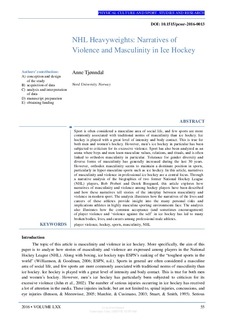| dc.contributor.author | Tjønndal, Anne | |
| dc.date.accessioned | 2016-05-27T08:45:56Z | |
| dc.date.accessioned | 2016-06-02T06:46:32Z | |
| dc.date.available | 2016-05-27T08:45:56Z | |
| dc.date.available | 2016-06-02T06:46:32Z | |
| dc.date.issued | 2016 | |
| dc.identifier.citation | Tjønndal, A. (2016). NHL heavyweights: narratives of violence and masculinity in ice hockey. Physical Culture and Sport. Studies and Research, 70(1), 55-68. doi: | nb_NO |
| dc.identifier.issn | 1899-4849 | |
| dc.identifier.uri | http://hdl.handle.net/11250/2391099 | |
| dc.description.abstract | Sport is often considered a masculine area of social life, and few sports are more commonly associated with traditional norms of masculinity than ice hockey. Ice hockey is played with a great level of intensity and body contact. This is true for both men and women’s hockey. However, men’s ice hockey in particular has been subjected to criticism for its excessive violence. Sport has also been analyzed as an arena where boys and men learn masculine values, relations, and rituals, and is often linked to orthodox masculinity in particular. Tolerance for gender diversity and diverse forms of masculinity has generally increased during the last 30 years. However, orthodox masculinity seems to maintain a dominate position in sports, particularly in hyper-masculine sports such as ice hockey. In this article, narratives of masculinity and violence in professional ice hockey are a central focus. Through a narrative analysis of the biographies of two former National Hockey League (NHL) players, Bob Probert and Derek Boogaard, this article explores how narratives of masculinity and violence among hockey players have been described and how these narratives tell stories of the interplay between masculinity and violence in modern sport. The analysis illustrates how the narratives of the lives and careers of these athletes provide insight into the many personal risks and implications athletes in highly masculine sporting environments face. The analysis also illustrates how the common acceptance (and sometimes encouragement) of player violence and ‘violence against the self’ in ice hockey has led to many broken bodies, lives, and careers among professional male athletes. | nb_NO |
| dc.language.iso | eng | nb_NO |
| dc.publisher | De Gruyter Open | nb_NO |
| dc.rights | Navngivelse-Ikkekommersiell-IngenBearbeidelse 3.0 Norge | * |
| dc.rights.uri | http://creativecommons.org/licenses/by-nc-nd/3.0/no/ | * |
| dc.title | NHL Heavyweights : Narratives of Violence and Masculinity in Ice Hockey | nb_NO |
| dc.type | Journal article | nb_NO |
| dc.type | Peer reviewed | nb_NO |
| dc.date.updated | 2016-05-27T08:45:56Z | |
| dc.rights.holder | © 2016, The Author(s) | nb_NO |
| dc.subject.nsi | VDP::Social science: 200::Social science in sports: 330 | nb_NO |
| dc.source.pagenumber | 55-68 | nb_NO |
| dc.source.volume | 70 | nb_NO |
| dc.source.journal | Physical Culture and Sport. Studies and Research | nb_NO |
| dc.source.issue | 1 | nb_NO |
| dc.identifier.doi | 10.1515/pcssr-2016-0013 | |
| dc.identifier.cristin | 1356776 | |

